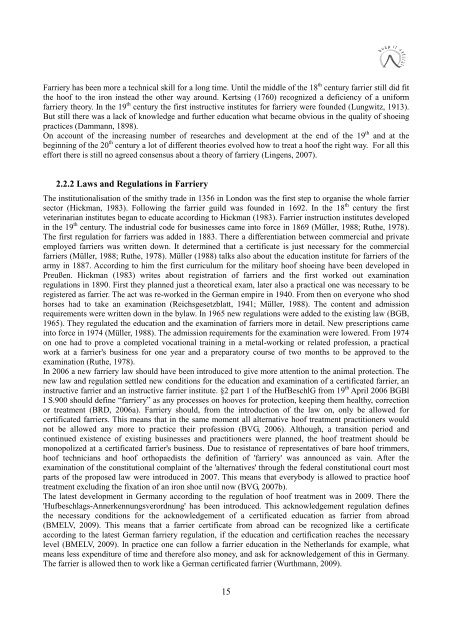Bachelor Thesis - Christina Kuenen - Hufpfleger
Bachelor Thesis - Christina Kuenen - Hufpfleger
Bachelor Thesis - Christina Kuenen - Hufpfleger
Create successful ePaper yourself
Turn your PDF publications into a flip-book with our unique Google optimized e-Paper software.
Farriery has been more a technical skill for a long time. Until the middle of the 18 th century farrier still did fit<br />
the hoof to the iron instead the other way around. Kertsing (1760) recognized a deficiency of a uniform<br />
farriery theory. In the 19 th century the first instructive institutes for farriery were founded (Lungwitz, 1913).<br />
But still there was a lack of knowledge and further education what became obvious in the quality of shoeing<br />
practices (Dammann, 1898).<br />
On account of the increasing number of researches and development at the end of the 19 th and at the<br />
beginning of the 20 th century a lot of different theories evolved how to treat a hoof the right way. For all this<br />
effort there is still no agreed consensus about a theory of farriery (Lingens, 2007).<br />
2.2.2 Laws and Regulations in Farriery<br />
The institutionalisation of the smithy trade in 1356 in London was the first step to organise the whole farrier<br />
sector (Hickman, 1983). Following the farrier guild was founded in 1692. In the 18 th century the first<br />
veterinarian institutes began to educate according to Hickman (1983). Farrier instruction institutes developed<br />
in the 19 th century. The industrial code for businesses came into force in 1869 (Müller, 1988; Ruthe, 1978).<br />
The first regulation for farriers was added in 1883. There a differentiation between commercial and private<br />
employed farriers was written down. It determined that a certificate is just necessary for the commercial<br />
farriers (Müller, 1988; Ruthe, 1978). Müller (1988) talks also about the education institute for farriers of the<br />
army in 1887. According to him the first curriculum for the military hoof shoeing have been developed in<br />
Preußen. Hickman (1983) writes about registration of farriers and the first worked out examination<br />
regulations in 1890. First they planned just a theoretical exam, later also a practical one was necessary to be<br />
registered as farrier. The act was re-worked in the German empire in 1940. From then on everyone who shod<br />
horses had to take an examination (Reichsgesetzblatt, 1941; Müller, 1988). The content and admission<br />
requirements were written down in the bylaw. In 1965 new regulations were added to the existing law (BGB,<br />
1965). They regulated the education and the examination of farriers more in detail. New prescriptions came<br />
into force in 1974 (Müller, 1988). The admission requirements for the examination were lowered. From 1974<br />
on one had to prove a completed vocational training in a metal-working or related profession, a practical<br />
work at a farrier's business for one year and a preparatory course of two months to be approved to the<br />
examination (Ruthe, 1978).<br />
In 2006 a new farriery law should have been introduced to give more attention to the animal protection. The<br />
new law and regulation settled new conditions for the education and examination of a certificated farrier, an<br />
instructive farrier and an instructive farrier institute. §2 part 1 of the HufBeschlG from 19 th April 2006 BGBl<br />
I S.900 should define “farriery” as any processes on hooves for protection, keeping them healthy, correction<br />
or treatment (BRD, 2006a). Farriery should, from the introduction of the law on, only be allowed for<br />
certificated farriers. This means that in the same moment all alternative hoof treatment practitioners would<br />
not be allowed any more to practice their profession (BVG, 2006). Although, a transition period and<br />
continued existence of existing businesses and practitioners were planned, the hoof treatment should be<br />
monopolized at a certificated farrier's business. Due to resistance of representatives of bare hoof trimmers,<br />
hoof technicians and hoof orthopaedists the definition of 'farriery' was announced as vain. After the<br />
examination of the constitutional complaint of the 'alternatives' through the federal constitutional court most<br />
parts of the proposed law were introduced in 2007. This means that everybody is allowed to practice hoof<br />
treatment excluding the fixation of an iron shoe until now (BVG, 2007b).<br />
The latest development in Germany according to the regulation of hoof treatment was in 2009. There the<br />
'Hufbeschlags-Annerkennungsverordnung' has been introduced. This acknowledgement regulation defines<br />
the necessary conditions for the acknowledgement of a certificated education as farrier from abroad<br />
(BMELV, 2009). This means that a farrier certificate from abroad can be recognized like a certificate<br />
according to the latest German farriery regulation, if the education and certification reaches the necessary<br />
level (BMELV, 2009). In practice one can follow a farrier education in the Netherlands for example, what<br />
means less expenditure of time and therefore also money, and ask for acknowledgement of this in Germany.<br />
The farrier is allowed then to work like a German certificated farrier (Wurthmann, 2009).<br />
15


